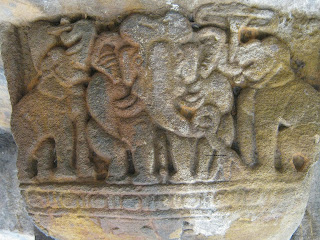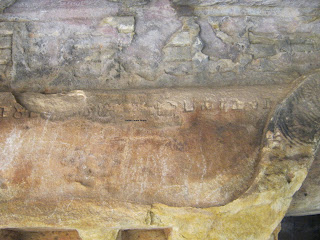Udayagiri and Khandagiri Hills at Bhubaneswar, Odisha, 2nd Century BCE...

Udayagiri caves:-
Starting with Cave number 14 instead of Cave number 1. Why so?
Wait...
Cave 14: Hati Gumpha (Elephant cave)
Ashoka, the Magadh King, attacked Kalinga and mentioned about his victory at Dhauli Giri near Bhubaneswar.
The Great King Kharabela of Kalinga attacked Magadh after ~100 years of Ashoka's attack on Kalinga, won the battle and took back the Kalinga Jina idol that was taken by a Nanda king of Magadh.
After the victory, Kharabela built/rebuilt the caves at Udayagiri/Khandagiri at Bhubaneswar and wrote the history on the stone walls of "Hati Gumpha".
One interesting thing is that the Hati Gumpha (made by Kharabela) faces straight towards the Dhauli Giri (made by Ashoka).
*But Kharabela did not destroy the monument created by Ashoka.*
Dhauli Giri is not visible from Hati Gumpha due to the high rise buildings and fog...
Kharabela's inscription at Hati Gumpha, Udayagiri, Bhubaneswar...
Let's start with Cave 1...
Cave 1: Rani Gumpha (Queen's Cave)
[Photo to be uploaded]
Cave 2: Bajaghara Gumpha (Cave for Music/Musical Instruments)
Cave 3: Chhota Hati Gumpha (Small Elephant Cave)
Cave 4: Alakapuri Gumpha
Cave 5: Jaya Bijaya Gumpha
Cave 6: Panasa Gumpha (Jackfruit cave)
Cave 7: Thakurani Gumpha
Cave 8: Patalapuri Gumpha
Cave 9: Manchapuri Swargapuri Gumpha
Cave 10 - Ganesha gumpha
To be updated...
Thanks
Ashish Kumar Nayak

Udayagiri caves:-
Starting with Cave number 14 instead of Cave number 1. Why so?
Wait...
Cave 14: Hati Gumpha (Elephant cave)
Ashoka, the Magadh King, attacked Kalinga and mentioned about his victory at Dhauli Giri near Bhubaneswar.
The Great King Kharabela of Kalinga attacked Magadh after ~100 years of Ashoka's attack on Kalinga, won the battle and took back the Kalinga Jina idol that was taken by a Nanda king of Magadh.
After the victory, Kharabela built/rebuilt the caves at Udayagiri/Khandagiri at Bhubaneswar and wrote the history on the stone walls of "Hati Gumpha".
One interesting thing is that the Hati Gumpha (made by Kharabela) faces straight towards the Dhauli Giri (made by Ashoka).
*But Kharabela did not destroy the monument created by Ashoka.*
Dhauli Giri is not visible from Hati Gumpha due to the high rise buildings and fog...
Kharabela's inscription at Hati Gumpha, Udayagiri, Bhubaneswar...
Let's start with Cave 1...
Cave 1: Rani Gumpha (Queen's Cave)
[Photo to be uploaded]
Cave 2: Bajaghara Gumpha (Cave for Music/Musical Instruments)
Cave 3: Chhota Hati Gumpha (Small Elephant Cave)
Cave 4: Alakapuri Gumpha
Cave 5: Jaya Bijaya Gumpha
Cave 6: Panasa Gumpha (Jackfruit cave)
Cave 7: Thakurani Gumpha
Cave 8: Patalapuri Gumpha
Cave 9: Manchapuri Swargapuri Gumpha
Cave 10 - Ganesha gumpha
To be updated...
Thanks
Ashish Kumar Nayak














































